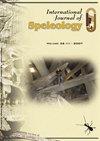Guano-derived morphologies and associated minerals found in Cova de sa Guitarreta, Llucmajor, Balearics
IF 1.3
4区 地球科学
Q3 GEOSCIENCES, MULTIDISCIPLINARY
引用次数: 1
Abstract
Cova de sa Guitarreta is located in the southern part of Mallorca Island (western Mediterranean). It was formed presumably by hypogenic processes in Upper Miocene reefal calcarenites. The cave hosts an important breeding colony of bats during the end of spring and early summer. Its microclimate is influenced by the presence of a thermal phreatic water table (27.7ºC) as well as by bat populations remaining in the cave along the reproductive season. The morphological bat-related features include bat claws and thumb marks scratches, together with several morphologies linked to bat excreta and aggressive leachates from guano. From the mineralogical point of view, this cave outstands regarding the presence of cave minerals linked to guano: nine phosphates have been identified, comprising three of them that are reported for the first time in Mallorcan caves (newberyite, struvite and whitlockite). Particularly interesting is the dichotomy between struvite and newberyite: the first one occurs when the cave is occupied by bat colonies (spring-summer), whereas in the colder seasons would occur the transformation of metastable struvite into a more stable newberyite. Caves with seasonal cyclical occupation of bat colonies could provide a new arena for the study of the guano-related mineral assemblages.巴利阿里群岛Llucmajor的Cova de sa Guitarreta中发现的鸟粪衍生形态和相关矿物
Cova de sa Guitarreta位于马略卡岛南部(地中海西部)。它可能是由上中新世reefal钙质砂屑岩的深成岩过程形成的。在春末夏初,洞穴里有一个重要的蝙蝠繁殖地。它的小气候受到热潜水水位(27.7ºC)的影响,也受到繁殖季节留在洞穴中的蝙蝠种群的影响。蝙蝠的形态特征包括蝙蝠爪和拇指痕迹抓痕,以及与蝙蝠排泄物和鸟粪中的侵蚀性浸出物有关的几种形态。从矿物学的角度来看,这个洞穴突出了与鸟粪有关的洞穴矿物的存在:已经鉴定出九种磷酸盐,其中三种是首次在马略卡岛洞穴中报道的(纽贝岩、鸟粪石和白榴石)。特别有趣的是鸟粪石和菜鸟石之间的二分法:第一种发生在洞穴被蝙蝠群落占据时(春夏),而在寒冷的季节,亚稳鸟粪石会转变为更稳定的菜鸟石。蝙蝠群落季节性周期性占据的洞穴可能为研究鸟粪相关矿物组合提供一个新的舞台。
本文章由计算机程序翻译,如有差异,请以英文原文为准。
求助全文
约1分钟内获得全文
求助全文
来源期刊

International Journal of Speleology
地学-地球科学综合
CiteScore
3.10
自引率
23.10%
发文量
12
审稿时长
>12 weeks
期刊介绍:
The International Journal of Speleology has the aim to get cave and karst science known to an increasing number of scientists and scholars. The journal therefore offers the opportunity to all scientists working in and on karst to publish their original research articles or their review papers in an open access, high quality peer reviewed scientific journal at no cost. The journal offers the authors online first, open access, a free PDF of their article, and a wide range of abstracting and indexing services.
 求助内容:
求助内容: 应助结果提醒方式:
应助结果提醒方式:


